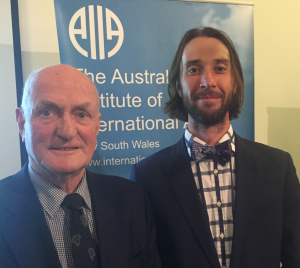After Paris: life in a changing climate
Dr Martin Tingley has a PhD from Harvard in Climate Sciences and is a member of a natural perils group in a leading Australian insurance company. On Tuesday 4 October he gave a rather depressing prognosis on global warming to 50 AIIA members and friends at Glover Cottages.
Martin said many myths have been created by global warming sceptics and denialists. Conspiracy theories abound, including pervasive ones about dark forces destroying free enterprise and creating a world government. One assertion of sceptics is that anthropogenic climate change has only recently been fabricated. In fact Swedish Nobel laureate Svante Arrhenius first discovered the warming effects of carbon dioxide in 1896, 120 years ago. Arrhenius correctly predicted that an increase in CO2 by 2 to 2.5 factors would result in global temperature rises of 3 to 4%.
Martin said CO2 increases move in lock step with temperature increases. Go back 10,000 years to the end of the Ice Age when everything was stable. Indeed the entire history of human society until the Industrial Revolution took place in conditions of climatic stability. But we are now experiencing rapid change as increasing quantities of CO2 are pumped into the atmosphere. He predicted that even if this can somehow be immediately stopped, the mean average world temperature will still, like a saucepan of water under which the stove has been turned down to simmer, inexorably increase by 2 degrees Celsius. His prediction was that this will occur within his lifetime, probably by 2036. The increase might be a 4 degree rise by 2100.
What will a 2 degree rise mean? The future is already here, but it’s just not evenly distributed. The poles are warming faster than the rest of the planet. But a new day-time temperature has now been recorded of 54 degrees Celsius in Kuwait and over 50 degrees in several other countries. Some of the consequences of warming are unexpected. A recent unprecedented heat wave in Russia caused an outbreak of anthrax. Extreme weather events such as cyclones and typhoons are not necessarily more frequent, but when they occur they will be more severe. Similarly, dry areas of the planet will get drier, but precipitation when it occurs will be heavier. Night-time temperature lows will increase faster than day-time highs. Sea levels will continue to rise. They did so over the last 20 years except, strangely, in 2011, when they went down, possibly due to an increase in precipitation over land (including a once in a life time filling of Lake Eyre in Australia). But Martin predicts a one metre sea-level rise by 2100, a catastrophe for five percent of the global population which lives less than 5 metres above existing sea levels.
As for the insurance industry, which Martin represents, he predicts higher and higher premiums as companies struggle to continue to make profits. Eventually individuals will simply be unable to afford them – leading to the possible demise of the industry, at least of home insurance and at least for most lower and middle income earners.
Report by Richard Broinowski
